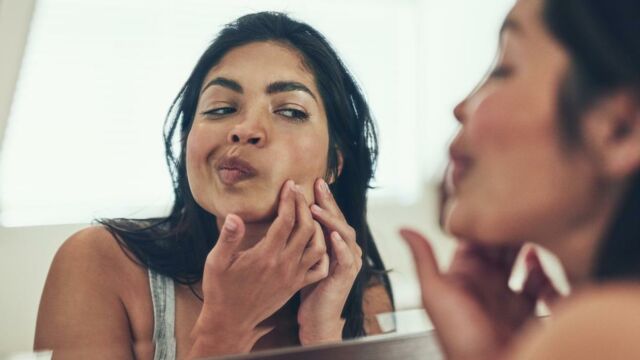Acne vs pimples, what’s the difference?

Some people are plagued with acne while others just suffer the odd pimple, but what’s the difference and can they be treated the same way?
Most acne sufferers would have noticed that different parts of their body exhibit different types of acne and pimples. But, even though we often use these two terms interchangeably, acne and pimples mean different things.
Discover our latest podcast
What causes acne and pimples
Acne and pimples are both caused by the overproduction of sebum, the buildup of dead skin cells, P. acnes bacteria and inflammation. Often, excess sebum and dead skin cells build up inside the pore or hair follicle. This build-up then becomes the perfect environment for acne-causing bacteria, which causes inflammation leading to red, pus-filled spots.
More under this adMore under this adWhat is acne
Also known by its scientific name, acne vulgaris, acne is actually a skin condition with pimples as a symptom. While pimples often occur alone, acne involves frequent breakouts consisting of multiple pimples. If you often find your face riddled with multiple spots, the chances are you’re suffering from acne. Luckily, there are many treatments available to combat this skin condition.
What are pimples
Pimples rear their ugly heads right about the age we reach puberty. During puberty, the skin starts to thicken, and your sebaceous glands begin to produce more oil, which is necessary to keep the skin hydrated and protected. However, when this oil - or sebum - mixes with dirt and dead skin cells, we often end up with a pimple. Pimples are just singular spots, but when appearing regularly in a cluster, it becomes acne.
More under this adMore under this adDifferent types of acne and pimples
Acne and pimples can come in a variety of different forms and can be either non-inflammatory or inflammatory.
Non-inflammatory acne
Non-inflammatory acne includes whiteheads and blackheads, which can often be found around the nose and chin. These types of acne are usually easy to treat and respond well to skincare ingredients such as salicylic, glycolic or lactic acid, and prescription retinoids.
Blackheads (open comedones)
Blackheads occur when a pore becomes clogged up with sebum and skin cells, but the pore stays open. The top layer of the clogged pore then becomes oxidised, leading to the characteristic black appearance.
More under this adMore under this adWhiteheads (closed comedones)
Whiteheads develop the same way as blackheads, except with whiteheads, the pore closes up, making it look like a white bump protruding from the skin.
Inflammatory acne
Acne and pimples that are red and inflamed are classed as inflammatory acne. Like non-inflammatory acne, inflammatory acne is caused by sebum and dead skin cells, but P.acnes bacteria also plays a part. This bacteria then causes an infection beneath the skin’s surface, resulting in large, painful pimples.
More under this adMore under this adPotent retinoids such as tretinoin are effective at treating inflammatory acne as well as products containing benzoyl peroxide. If your acne is particularly stubborn, a doctor may prescribe an antibiotic to take alongside the benzoyl peroxide.
Papules
Papules occur when the walls around your pores become so inflamed that they break down, resulting in hard clogged pores which are tender and red.
More under this adMore under this adPustules
Pustules occur in the same way as papules but are filled with pus. This results in pimples that are red with a white or yellow top.
Nodules
Nodules develop when clogged and inflamed pores suffer further irritation and grow larger. Nodules often form deeper in the skin and don’t respond well to normal over the counter products. Instead, prescription treatments will be required.
More under this adMore under this adCysts
Cysts are formed when a combination of sebum, dead skin cells and bacteria clog the pores, leading to a severe infection.Cysts are the largest form of acne and occur even deeper in the skin than nodules. Due to the level of infection, cysts are very painful to the touch, and along with nodules, they are the most intense form of acne.